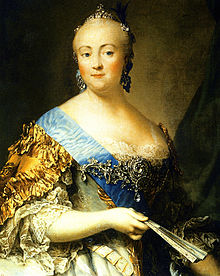
Back Elisabeth van Rusland Afrikaans Isabel I de Rusia AN إليزابيث إمبراطورة روسيا Arabic اليزابيث امبراطوره روسيا ARZ Isabel I de Rusia AST Yelizaveta Petrovna Azerbaijani امپراتریس الیزابت AZB Елизавета Петровна Bashkir Лізавета Пятроўна Byelorussian Лізавета Пятроўна BE-X-OLD
| Elizabeth | |||||
|---|---|---|---|---|---|
 Portrait by Vigilius Eriksen, 1757 | |||||
| Empress of Russia | |||||
| Reign | 6 December (25 November) 1741 – 5 January (25 December) 1762 | ||||
| Coronation | 6 May (25 April) 1742 | ||||
| Predecessor | Ivan VI | ||||
| Successor | Peter III | ||||
| Born | Elizaveta Petrovna Romanova 29 December 1709 Kolomenskoye, Moscow, Tsardom of Russia | ||||
| Died | 5 January 1762 (aged 52) Winter Palace, Saint Petersburg, Russian Empire | ||||
| Burial | 3 February 1762 (O.S.) | ||||
| |||||
| House | Romanov | ||||
| Father | Peter I of Russia | ||||
| Mother | Catherine I of Russia | ||||
| Religion | Russian Orthodox | ||||
| Signature |  | ||||

Elizabeth or Elizaveta Petrovna (Russian: Елизаве́та Петро́вна; 29 December [O.S. 18 December] 1709 – 5 January [O.S. 25 December] 1762) was Empress of Russia from 1741 until her death in 1762. She remains one of the most popular Russian monarchs because of her decision not to execute a single person during her reign, her numerous construction projects, and her strong opposition to Prussian policies.[1]
The second-eldest daughter of Tsar Peter the Great (r. 1682–1725), Elizabeth lived through the confused successions of her father's descendants following her half-brother Alexei's death in 1718. The throne first passed to her mother Catherine I of Russia (r. 1725–1727), then to her nephew Peter II, who died in 1730 and was succeeded by Elizabeth's first cousin Anna (r. 1730–1740). After the brief rule of Anna's infant great-nephew, Ivan VI, Elizabeth seized the throne with the military's support and declared her own nephew, the future Peter III, her heir.
During her reign Elizabeth continued the policies of her father and brought about a remarkable Age of Enlightenment in Russia. Her domestic policies allowed the nobles to gain dominance in local government while shortening their terms of service to the state. She encouraged Mikhail Lomonosov's foundation of the University of Moscow, the highest-ranking Russian educational institution. Her court became one of the most splendid in all Europe, especially regarding architecture: she modernised Russia's roads, encouraged Ivan Shuvalov's foundation of the Imperial Academy of Arts, and financed grandiose Baroque projects of her favourite architect, Bartolomeo Rastrelli, particularly in Peterhof Palace. The Winter Palace and the Smolny Cathedral in Saint Petersburg are among the chief monuments of her reign.[1]
Elizabeth led the Russian Empire during the two major European conflicts of her time: the War of Austrian Succession (1740–1748) and the Seven Years' War (1756–1763). She and diplomat Aleksey Bestuzhev-Ryumin solved the first event by forming an alliance with Austria and France, but indirectly caused the second. Russian troops enjoyed several victories against Prussia and briefly occupied Berlin, but when Frederick the Great was finally considering surrender in January 1762, the Russian Empress died. She was the last agnatic member of the House of Romanov to reign over the Russian Empire.
- ^ a b Antonov 2006, p. 105.